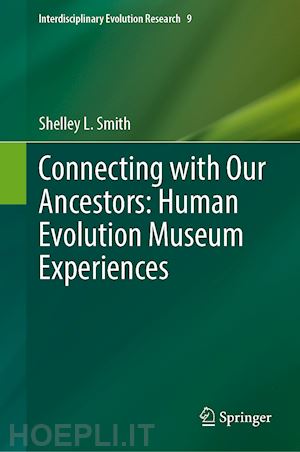
Questo prodotto usufruisce delle SPEDIZIONI GRATIS
selezionando l'opzione Corriere Veloce in fase di ordine.
Pagabile anche con Carta della cultura giovani e del merito, 18App Bonus Cultura e Carta del Docente
This book combines documentation and analysis of the contents of exhibits in 12 museums (Part 1) with interviews with experts involved in the creation of exhibits (Part 2) to explore variation in human evolution exhibits.
To be successful, museum exhibits must make a personal connection with visitors, inspiring them to learn more. Human evolution exhibits thus need contemporary relevance. It is crucial to find ways to bind our deep past to our lives today. Presenting our story, and our collective history, some human evolution exhibits reach an audience of millions each year. An understanding of evolution is fundamental to modern biology, and a lack of knowledge of basic principles has practical consequences, including impairing reception of health messages. The goal of the volume is to stimulate discussion of how the presentation of evolution, and in particular human evolution, can be improved, contributing to scientific literacy and engagement with evolutionary science. To enhance relevance to a broader public, the author argues that incorporation of evolutionary medicine and clearer explanations of ancestry and human biological variation are needed.
The surveyed museums include four in Texas, the author’s home state, seven additional renowned U.S. museums, and the Natural History Museum in London. Some of the 35 interviewees are prominent academic researchers; other contribute their expertise in design, art, and education. Topics discussed include exhibit content and changing exhibits, the ideal vs. reality in exhibit creation, self-assessments of exhibits, education and “edutainment,” and exhibit content intersections with religion, politics, and the history of representations of race / human biological variation. A bibliographic essay, appendices, and text boxes provide additional information for readers desiring more in-depth study.
This volume is of interest to a wide range of readers in anthropology, museum studies, and science communication.
Part I: Museum Exhibits.- Chapter 1: Introduction.- Chapter 2: The Texas Museums.- Chapter 3: The National Museum of Natural History.- Chapter 4: The American Museum of Natural History.- Chapter 5: The Great Lakes Region: Chicago and Cleveland.- Chapter 6: The West Coast: California.- Chapter 7: In the Center: The Denver Museum of Nature and Science.- Chapter 8: The “Outgroup”: London’s Natural History Museum.- Part II: Interviews.- Chapter 9: Content and Change.- Chapter 10: Fantasy and Reality.- Chapter 11: Self-Assessment.- Chapter 12: Education and “Edutainment”.- Chapter 13: Religion.- Chapter 14: Politics.- Chapter 15: Race and History.- Chapter 16: Conclusion.
Shelley L. Smith is a biological anthropologist with over 30 years’ experience teaching human evolution and human biology. She earned her Ph.D. in Anthropology from the University of Michigan in 1990 and was a postdoctoral researcher at the National Museum of Natural History (Smithsonian Institution, 1990-1991). In 1991, she joined the faculty of the University of Texas at Arlington, where she continues to serve today as Professor of Anthropology in the Department of Sociology and Anthropology. Her previous research has explored human skeletal variation, dental development, childhood long bone, facial tissue, and maxillary sinus growth and development, and the maturation of Homo erectus. She has published works in the fields of human biology, the history and philosophy of human evolutionary science, hominin paleontology, and forensic anthropology. An emphasis on human and earlier hominin variation and its interpretation unites all the areas of her research. Since 2016, her focus has been on the presentation of human evolution to museum visitors and the role of museums in promoting science literacy, the understanding of evolutionary theory and principles, and an appreciation of Deep Time. In addition to Connecting with Our Ancestors, she is the author of an in-progress book describing the multi-decade project of creating the Smithsonian’s Hall of Human Origins, Developing the Hall of Human Origins: Adaptive Resilience.











Il sito utilizza cookie ed altri strumenti di tracciamento che raccolgono informazioni dal dispositivo dell’utente. Oltre ai cookie tecnici ed analitici aggregati, strettamente necessari per il funzionamento di questo sito web, previo consenso dell’utente possono essere installati cookie di profilazione e marketing e cookie dei social media. Cliccando su “Accetto tutti i cookie” saranno attivate tutte le categorie di cookie. Per accettare solo deterninate categorie di cookie, cliccare invece su “Impostazioni cookie”. Chiudendo il banner o continuando a navigare saranno installati solo cookie tecnici. Per maggiori dettagli, consultare la Cookie Policy.